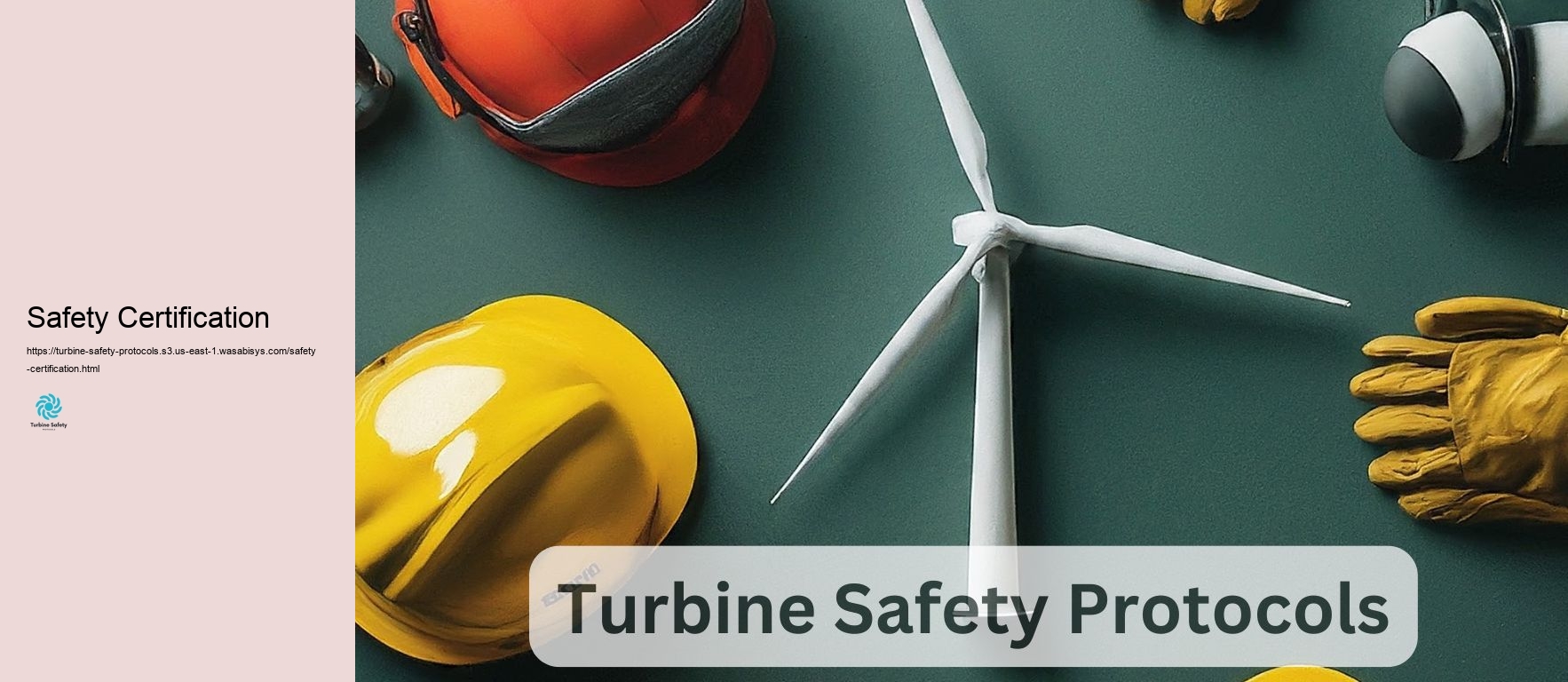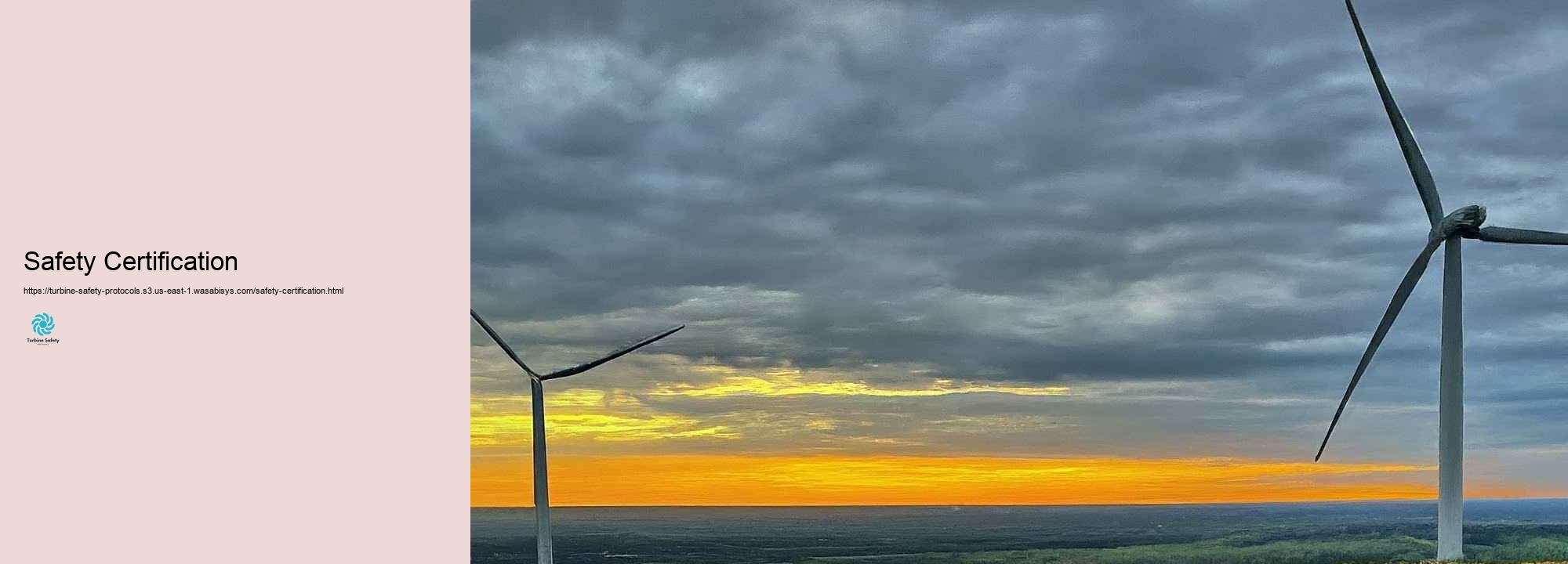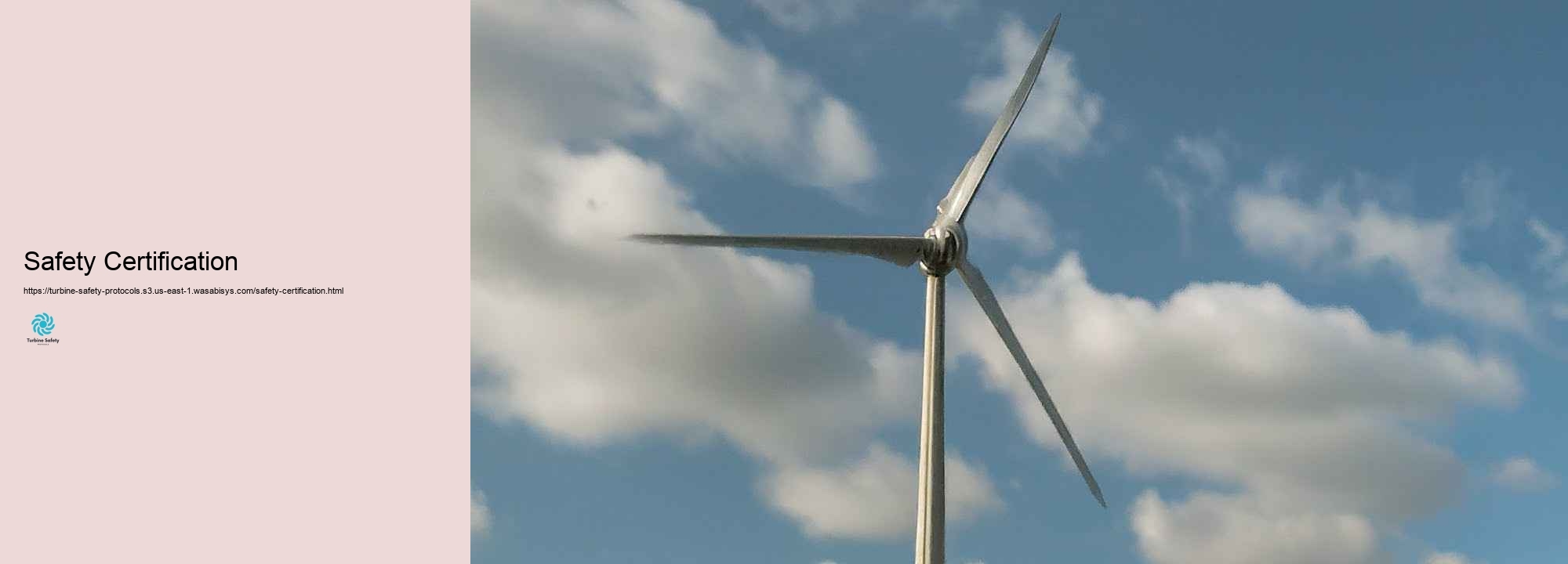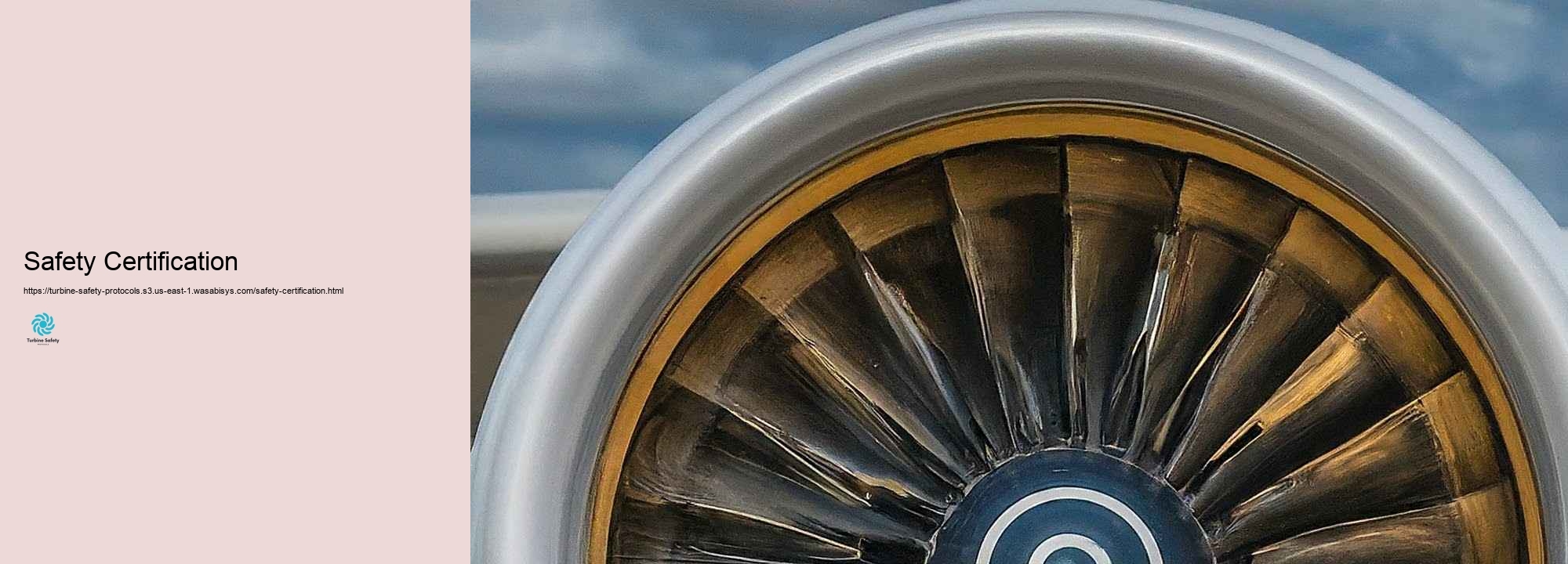

Turbine safety protocols are vital components of power generation operations, developed to safeguard personnel, devices, and the setting from feasible threats related to turbine operation. These protocols consist of a vast variety of approaches, treatments, and guidelines that govern every element of turbine management, from regular upkeep to emergency situation reaction. Comprehending and using these safety protocols is crucial for ensuring the protected, efficient, and trusted treatment of turbines in numerous power generation configurations. Safety Documentation At the core of turbine safety protocols is the concept of risk evaluation and keeping track of. This includes systematically acknowledging feasible threats related to turbine procedure, examining the probability and possible impacts of these threats, and using steps to lessen or get rid of dangers. Danger analyses are typically accomplished consistently and updated whenever there are changes in equipment, treatments, or operating troubles. Individual protective tools (PPE) creates a vital line of defense in turbine safety protocols. Safety Certification Relying on the details task and atmosphere, PPE may consist of hard hats, shatterproof glass, ear safety, steel-toed boots, flame-resistant clothing, and decline protection devices. Ideal training in the usage, upkeep, and constraints of PPE is important to make certain its performance in safeguarding workers from prospective threats. Lockout/tagout (LOTO) treatments are fundamental to turbine safety, especially during maintenance and repair procedures. These treatments make sure that possibly hazardous energy sources are properly separated and controlled prior to job starts. LOTO protocols frequently consist of de-energizing devices, shutting out power seclusion gizmos, and marking them to show that work remains in development. Just certified workers are enabled to get rid of locks and tags, guaranteeing that devices is not inadvertently fresh while work is being carried out. Constrained area gain access to procedures are another essential element of turbine safety protocols. Several locations within turbine systems, such as central heating boilers, condensers, and storage tanks, are identified as constricted spaces as a result of their restricted ways of access and leave and prospective for hazardous environments. Stringent protocols control entry right into these locations, containing weather screening, air flow, rescue preparing, and taking advantage of certified aides to check workers inside the area. Fall protection is an exceptionally crucial issue in turbine safety, specifically for wind generators and different other high structures. Extensive autumn defense protocols consist of making use of guardrails, guard, and specific autumn uneasiness systems. Workers are trained in the suitable usage loss defense equipment and the recognition of loss dangers. Typical evaluation and maintenance of fall protection tools are essential components of these protocols. Electric safety protocols are vital in turbine procedures as an outcome of the exposure of high-voltage systems. These protocols include utilizing shielded devices and tools, appropriate grounding procedures, and the execution of arc flash protection actions. Just licensed electric employees are permitted to deal with invigorated tools, and extensive treatments control the de-energization and re-energization of electrical systems. Fire safety is one more essential element of turbine safety protocols. This consists of the installment and maintenance of fire discovery and reductions systems, typical fire drills, and training in using firefighting tools. Protocols in addition address the appropriate storage room and handling of combustible materials and the implementation of cozy job treatments for tasks such as welding or grinding that can possibly ignite fires. Emergency situation reaction planning is a basic component of turbine safety protocols. This entails developing and frequently upgrading detailed emergency activity plans that address different possible circumstances, such as fires, surges, chemical spills, or major climate occasions. Regular drills and simulations are carried out to guarantee that all employees recognize with emergency situation therapies and can respond effectively in situation scenarios. Communication protocols play a crucial obligation in turbine safety. Clear, trusted interaction is needed for collaborating with tasks, reporting hazards, and responding to emergency situations. This includes making use of basic terms, clear signage and labeling, and developed networks for reporting safety concerns or near-miss events. Training and expertise evaluation are indispensable to turbine safety protocols. All personnel collaborating with or around generators have to obtain thorough safety training proper to their duties and responsibilities. This training is normally continuous, with regular communication program and updates to address brand-new technologies or transforming safety criteria. Effectiveness analyses guarantee that employees have not just obtained training yet can show the required abilities and experience to do their duties securely. Maintenance and evaluation protocols are vital for establishing and taking care of possible safety problems before they cause accidents or equipment failings. These protocols usually consist of normal scheduled assessments, precautionary upkeep jobs, and problem tracking of necessary components. Non-destructive evaluating strategies, such as ultrasonic screening or thermography, are commonly made use of to locate prospective concerns that may not turn up during normal visual evaluations. Ecological safety protocols deal with the potential results of turbine operations on the bordering community. This contains steps to prevent and respond to oil spills or various other chemical launches, protocols for handling waste products, and treatments for minimizing ecological air pollution and wild pets influences, especially when it pertains to wind generators. Cybersecurity protocols have really ended up being considerably crucial in turbine safety as control systems become much more interconnected and digitalized. These protocols attend to the protection of essential control systems from cyber threats, containing procedures such as firewall programs, breach discovery systems, and rigorous access to controls for both physical and digital possessions. Specialist monitoring is one more critical facet of turbine safety protocols. Great deals of power generation facilities trust professionals for specialized maintenance or fixing tasks. Protocols make certain that service providers are appropriately vetted, learnt site-specific safety treatments, and integrated right into the general safety monitoring system of the center. Consistent enhancement is a vital concept in turbine safety protocols. This requires consistently analyzing and upgrading safety procedures based upon occasion evaluations, near-miss records, industry best practices, and technical improvements. Safety committees, requiring both checking and employees, frequently add in driving these improvement efforts. Turbine safety protocols integrate a considerable collection of practices, treatments, and standards created to guarantee the safe and secure procedure of generators in power generation centers. From specific safety tools and lockout/tagout treatments to emergency situation comments preparation and cybersecurity activities, these protocols settle the varied variety of possible threats related to turbine procedures. By carefully using and consistently improving these safety protocols, power generation centers can shield their workforce, gadgets, and the establishing while maintaining efficient and reputable treatments. As the power generation sector remains to advance, so likewise will definitely these safety protocols, adapting to brand-new technologies and obstacles to make certain the greatest demands of safety in turbine treatments.
Generators are vital elements in power generation, and their safe treatment and maintenance are important to make sure the integrity of power supply and the safety of employees. Turbine maintenance and operation include a range of tasks that, or else executed appropriately, can bring about crashes, injuries, and additionally deaths. Therefore, adhering to essential safety treatments is essential to reduce threats and assurance a risk-free work environment. Prior to any kind of maintenance task begins, it is important to execute extensive pre-maintenance checks. These checks consist of reviewing the turbine's functional history, evaluating the turbine and its components for any kind of indicators of wear or problems, and making sure that all required safety tools is provided and in superb issue. In addition, all personnel associated with the upkeep needs to be properly qualified and knowledgeable about the information safety therapies related to the turbine design and the tasks handy. Among among one of the most critical safety procedures in turbine upkeep is the lockout/tagout(LOTO )procedure. This therapy ensures that the turbine is safely de-energized and can not be started unintentionally throughout maintenance. LOTO consists of literally protecting the turbine's power source and marking it to signal others that upkeep remains in progression. This action is essential to stop unanticipated start-up, which can lead to serious injuries or casualties. Personal Safety Tools (PPE) is essential for guarding staff members from numerous risks during turbine upkeep and operation. PPE contains building hats, safety glasses, gloves, earplugs, and respirators.
Ensuring the safety of wind turbine operations is non-negotiable! From rigorous safety protocols to continuous monitoring, every step counts in protecting our workforce and maintaining operational integrity.https://t.co/6qMvcBwr4R
— Turbine Training And Operation (@turbinetraine) August 20, 2024
Making sure the safety of personnel servicing and around wind wind turbines is critical in the wind power industry. Carrying out effective turbine safety protocols is essential for quiting mishaps, securing staff members, and maintaining the honesty of wind power procedures. This thorough guide lays out the process of developing and implementing substantial safety protocols for wind turbine treatments. The initial step in performing dependable turbine safety protocols is to do a comprehensive threat evaluation. This entails establishing all potential threats gotten in touch with turbine procedure, maintenance, and repair work solution. Personal Protective Equipment (PPE) Common dangers include drops from altitude, electric dangers, mechanical threats from moving components, and ecological threats such as serious weather. The threat analysis should be considerable, covering all aspects of turbine work from ground procedures to nacelle get to and blade maintenance. As soon as risks are identified, the next activity is to develop particular safety therapies to fix each determined risk. These therapies should be described and cover all aspects of turbine work. For instance, protocols for operating at height ought to contain specs for loss protection tools, treatments for protecting gadgets, and standards for risk-free climb and descent of the turbine tower. Electric safety procedures needs to information lockout/tagout processes, proper use of protected devices, and emergency circumstance feedback plans for electric events. Training is a vital part of carrying out safety protocols. All personnel servicing or around turbines require to obtain comprehensive safety training. This training requirements to cover basic safety ideas along with specific therapies relevant to their features. It's vital to contain both academic understanding and beneficial abilities training. For example, workers need to not just acknowledge the importance of autumn defense however additionally excel in properly using and using harnesses and other safety gadgets. Establishing a clear pecking order and interaction system is the following essential action. This entails assigning safety law enforcement agent, defining functions and obligations for all personnel, and developing clear communication protocols. Emergency scenario action procedures should certainly be clearly specified, consisting of simply how to call emergency scenario services and leave hurt employees from the turbine. Regular safety conferences and run-throughs require to be set up to make certain persisting interaction worrying safety problems and updates to protocols. Applying a resilient system for specific safety devices (PPE) is necessary. This includes not simply providing ideal PPE such as building hats, unbreakable glass, handwear covers, and fall safety devices however in addition guaranteeing that all devices is successfully preserved, taken a look at often, and changed when necessary. Clear standards has to be developed for when and specifically how PPE should be used, and there need to be absolutely no resistance for non-compliance with PPE needs. Creating a culture of safety is vital for the success of any sort of safety procedure. This includes growing an environment where safety is every person obligation and where employees truly feel urged to speak out concerning safety troubles without worry of retaliation. Leadership needs to noticeably sustain and prioritize safety, setting an instance for all staff members. Applying a benefit system for safety consistency and development can aid reinforce the value of safety in day-to-day operations. Typical safety audits and evaluations are vital for keeping effective safety protocols. These should be accomplished at dealt with durations and needs to cover all components of turbine operations. Audits should certainly evaluate conformity with developed safety therapies, the problem of safety gadgets, and the overall safety society of the company. Any type of troubles identified throughout these audits should be resolved right away, with clear activity techniques and follow-up procedures. Producing and using an incident reporting and examination system is an additional crucial action. All accidents, near-misses, and safety problems need to be reported and extensively explored. This system ought to be developed to identify root causes of occasions and to develop safeguard to avoid similar occurrences in the future. It's crucial to create an ambience where reporting is urged and deemed a favorable step in the direction of boosting basic safety. Integrating innovation into safety protocols can considerably improve their performance. This might include making use of drones for turbine examinations to decline the demand for dangerous climbs up, executing electronic systems for safety lists and insurance coverage, or using wearable modern-day innovation to track employee safety in real-time. As new technologies occur, safety protocols should certainly be updated to consist of these developments. Cooperation with turbine producers and market buddies is a crucial aspect of applying dependable safety protocols. This consists of staying existing with supplier recommendations for safe procedure and upkeep, along with joining field conversation forums and working groups focused on safety. Sharing optimal practices and lessons discovered with numerous other drivers can aid boost safety throughout the sector. Weather condition monitoring and response protocols are important for wind turbine safety. This consists of using systems to check local weather and developing clear criteria for when to suspend procedures due to destructive environment. Treatments should be in area for safeguarding gadgets and leaving workers in scenario of major weather celebrations. Establishing protocols for taking care of tiredness and tension amongst employees is another vital action. Collaborating with wind generators can be actually and psychologically requiring, and exhaustion can significantly increase the danger of problems. Performing work-rest schedules, giving sufficient breaks, and tracking worker tiredness degrees are all important facets of a detailed safety method. Typical review and upgrade of safety protocols is crucial to make certain they remain to be efficient and proper. This has to be done at least every year, or a great deal more usually if there are substantial modifications in treatments, devices, or standards. The assessment procedure must involve input from workers in all degrees, along with consideration of sector finest methods and any kind of lessons gained from occurrences or near-misses. It's vital to establish metrics for assessing the performance of safety protocols. This might consist of tracking case rates, consistency with safety treatments, and participation in safety training. Regular coverage on these metrics can assist identify areas for enhancement and show the company dedication to safety. Carrying out trusted turbine safety protocols is an in-depth procedure that require continual commitment and focus. By adhering to these actions, wind power chauffeurs can generate a resilient safety culture that safeguards workers, decreases dangers, and adds to the basic success and sustainability of wind power procedures. Keep in mind, safety is not a single execution however a consistent procedure of remodelling and wariness.


Safety criteria and conformity are essential in turbine treatments, whether in wind, hydroelectric, or thermal nuclear reactor. These needs are made to protect staff members, make certain functional honesty, and reduce environmental influences. Following these standards is not just a legal requirement yet in addition a vital facet of maintaining reliable and sustainable power manufacturing. Amongst the vital safety requirements in turbine procedures is the Occupational Safety and Wellness Management (OSHA) standards. These standards cover a substantial range of safety facets, including loss safety, electrical safety, and danger interaction. For wind wind turbines, OSHA has specific criteria attending to the unique difficulties of operating at altitudes and in restricted rooms. Conformity with OSHA requirements consists of regular safety audits, correct training of workers, and execution of safety protocols personalized to the specific threats associated with turbine treatments. The International Electrotechnical Payment (IEC) gives another collection of essential demands for turbine safety, specifically for wind generators. The IEC 61400 series of demands covers various elements of wind turbine design, installment, and treatment. These requirements address worries such as structural stability, electrical systems, and effectiveness assessment. Compliance with IEC criteria is usually a demand for accreditation and is essential for making certain the reliability and safety of wind turbine operations. For hydroelectric wind generators, the Federal Energy Governing Settlement (FERC) in the United States states thorough safety criteria. These criteria cover dam safety, emergency scenario action strategies, and operational therapies. Consistency with FERC standards includes normal examinations, maintenance of safety devices, and development of robust emergency situation reaction protocols. In the world of thermal nuclear power plant, the American Society of Mechanical Developers (ASME) offers important safety standards for turbine procedures. The ASME Central heating boiler and Pressure Vessel Code is specifically appropriate, attending to the design, fabrication, and examination of pressure-containing components in thermal nuclear power plant. Adherence to these demands is essential for stopping ruining failings and making certain the lasting dependability of turbine systems. Ecological consistency is another vital aspect of turbine operations. For wind wind turbines, this often includes adherence to wild animals defense requirements, such as those established by the UNITED STATE Fish and Wild Animals Solution. These criteria objective to reduce the influence of wind cattle ranches on bird and bat people. Consistency might include implementing wild animals security programs, transforming turbine operations during movement durations, and making use of contemporary technologies to deter wild pets accidents. In hydroelectric treatments, ecological conformity typically focuses on water high quality and fish security. Criteria established by ecological business call for motorists to protect minimum water circulations, screen water top quality, and implement fish passage systems. Compliance with these requirements is vital for maintaining power generation with eco-friendly preservation. For thermal nuclear reactor, air quality standards established by epa are an important conformity location. This involves sticking to discharge constraints for toxic substances such as sulfur dioxide, nitrogen oxides, and particle issue. Conformity regularly requirements the installment and maintenance of discharge control innovations and regular surveillance of exhaust gases. Cybersecurity has come to be a progressively important element of safety criteria in turbine procedures. The North American Electric Dependability Corporation (NERC) Important Facilities Defense (CIP) demands give criteria for protecting the operational contemporary technology systems that control generators and different other power generation equipment. Conformity with these standards entails implementing robust cybersecurity procedures, performing normal vulnerability analyses, and training employees in cybersecurity finest methods. Safety requirements in addition extend to the upkeep and analysis of generators. For wind generators, this consists of regular examinations of blades, nacelles, and towers. Requirements regularly define the uniformity and degree of these examinations, in addition to the accreditations required for assessment personnel. Equivalent standards exist for hydroelectric and thermal generators, with specific emphasis areas such as blades stability, birthing problem, and resonance analysis. Emergency situation readiness is another vital facet of safety requirements in turbine procedures. This entails producing and preserving emergency situation feedback prepares that address various scenarios, from tools failings to all-natural catastrophes. Safety Monitoring Systems Conformity with these standards typically calls for regular drills, control with regional emergency services, and continuous updating of reaction protocols based upon lessons discovered and evolving perfect techniques. Specific safety gadgets (PPE) demands are crucial in assuring worker safety throughout turbine operations and maintenance. These criteria specify the proper PPE for various jobs, from basic hard hats and shatterproof glass to specialized loss protection tools for wind turbine specialists. Compliance consists of not only providing the appropriate PPE however likewise guaranteeing its appropriate use and upkeep. Training and accreditation needs play a crucial feature in protecting safety in turbine procedures. A number of jurisdictions require drivers and upkeep personnel to undergo specific training and obtain accreditations. For wind generators, this may consist of credentials in operating at elevations, rescue operations, and certain turbine modern technologies. Hydroelectric and thermal plant drivers typically call for certifications in areas such as control space operations, electrical safety, and hazardous product dealing with. Sound exhaust standards are specifically appropriate for wind generators. Countless territories have details limitations on the sound levels that generators can develop, especially in distance to residential areas. Conformity with these criteria might involve careful siting of wind generators, execution of sound decrease developments, and regular security of audio degrees. Fire safety requirements are crucial throughout all type of turbine treatments. For wind wind turbines, this consists of fire exploration and reductions systems in nacelles. In thermal plants, comprehensive fire safety systems are required throughout the center. Conformity entails not just mounting optimal fire safety gadgets nevertheless additionally performing regular fire drills and maintaining clear discharge treatments. Quality monitoring standards such as ISO 9001 are progressively being pertaining to turbine treatments. While not purely safety demands, these premium quality management systems normally include safety elements and can add to general useful safety by seeing to it routine, top notch procedures and therapies. Conformity with vital safety demands in turbine procedures is a varied and recurring procedure. It calls for a considerable strategy that addresses staff member safety, environmental management, cybersecurity, and practical integrity. As development and ideal techniques develop, so also do these requirements, asking for drivers to continue to be informed and versatile. By focusing on conformity with these criteria, turbine vehicle drivers not just fulfill authorized demands nonetheless additionally contribute to the overall safety, efficiency, and sustainability of power production.
Turbine safety is an essential facet of wind energy procedures, including a wide range of techniques and procedures made to secure staff members, equipment, and the atmosphere. As wind wind turbines continue to grow in size and ins and out, performing and adhering to finest safety techniques winds up being considerably critical. This short post uncovers essential techniques and techniques for decreasing dangers and quiting crashes in turbine operations and upkeep. Among the important concepts of turbine safety is complete risk assessment. Prior to any kind of type of work is carried out on or around a turbine, an extensive exam of potential dangers need to be conducted. This consists of assessing environmental issues, such as wind price and weather report, in addition to the particular risks connected with the job at hand. Danger examinations needs to be dynamic, regularly upgraded to reflect changing problems or new details, and connected plainly to all workers associated with the treatment. Personal Safety Instruments (PPE) is an important component of turbine safety. Workers have to be supplied with appropriate safety tools, consisting of building and construction hats, unbreakable glass, handwear covers, and steel-toed boots. For operate at altitudes, specialized autumn protection tools is needed. This frequently consists of full-body harnesses, lanyards, and anchor elements. Typical evaluation and maintenance of PPE are crucial to guarantee its performance. Training in the correct use and care of safety devices is just as important, as also one of the most reliable equipment is just effective when taken advantage of appropriately. Operating at altitudes offers among one of one of the most considerable threats in turbine treatments. Finest techniques for altitude safety consist of using loss concern systems, right ladder safety protocols, and the execution of rescue strategies. Several wind ranches are presently tackling advanced accessibility systems, such as service lifts, to reduce the hazards related to ladder climbs up. Routine training in elevation safety and rescue treatments is important, including practical workouts and simulations of emergency circumstance situations. Electric safety is an additional crucial location in turbine procedures. Wind turbines include high-voltage systems, and teaming up with or around these systems ask for specialized knowledge and preventative procedures. Lock-out/tag-out treatments are crucial when implementing upkeep on electric systems to make sure that equipment is properly de-energized prior to task starts. Just certified and certified workers must solution electric systems, and routine electric safety training need to be provided to all important personnel.


Safety equipment plays an important role in turbine procedures, working as the first line of security versus possible risks and ensuring the wellness of employees operating in power generation facilities. The varied range of safety tools used in turbine operations reflects the complicated and possibly damaging nature of these ambiences, where heats up, pressurized systems, turning equipment, and electric risks are common. Individual Safety Tools (PPE) types the structure of safety tools in turbine treatments. Construction hats are necessary for securing versus dropping points and head effects, especially in locations with over work or in constricted rooms within the turbine structure. Shatterproof glass or safety glasses shield the eyes from flying particles, dust, and prospective chemical dashboards. In locations with high audio levels, such as near running turbines or in generator spaces, hearing defense in the type of earplugs or earmuffs is important to quit lasting listening to damages. Steel-toed boots are typical shoes in turbine atmospheres, protecting against dropping things and giving slip resistance on potentially slick surface. In locations where there's a danger of arc flash or fire, flame-resistant clothes is necessary. This certain apparel is made to self-extinguish and offer an obstacle against thermal energy, minimizing the strength of melt injuries in instance of an electrical arc or flash fire. Fall protection devices is particularly important in turbine procedures, especially for wind generators where operate at height is common. Full-body harnesses, lanyards, and self-retracting lifelines are important elements of a fall apprehension system. These systems are made to safely stop a loss and decline the pressures put in on the body. Support factors, whether lasting installations or short-lived setups, supply secured add-on factors for these systems. For wind turbine maintenance, specialized climbing up and placing devices might also be utilized to permit workers to firmly gain access to various parts of the turbine framework. Respiratory system protection gadgets is required in specific turbine procedure situations. In situations where airborne toxins exist, such as throughout cleansing procedures or when handling specific chemicals, respirators or breathing device might be required. These can array from basic dust masks to added complex supplied-air systems, relying on the nature and focus of the air-borne hazards. Lockout/Tagout (LOTO) gadgets is necessary for ensuring that machinery and tools are properly de-energized throughout maintenance or repair work. This devices normally contains locks, tags, and gadgets for dividing power sources. Ideal use LOTO tools stops the unforeseen start-up or launch of saved power, which could cause significant injury or death. Gas detection equipment is important in turbine treatments, specifically in confined areas or places where there's a possibility for gas leaks. Mobile gas detectors can alert employees to the existence of flammable gases, oxygen lack, or harmful gases such as carbon monoxide. In some centers, taken care of gas discovery systems are established to deal consistent tracking and automated alarm systems. Fire safety equipment is a vital aspect of turbine operation safety. This consists of fire extinguishers tactically located throughout the center, fire decreases systems (such as lawn sprinklers or aeriform reductions systems), and fire alarms. In places with details fire risks, such as those including flammable liquids or electric devices, specialized fire suppression gadgets might be used. Electric safety devices is vital in turbine procedures as a result of the existence of high-voltage systems. Insulated devices, voltage detectors, and arc blink safety equipment are vital for staff members taking care of electrical systems. Rubber insulating handwear covers, together with leather guards, offer protection versus electrical shock and arc flash injuries. Shielding blankets and floor coverings can be used to cover invigorated tools or to deal a shielding barrier for employees. Emergency situation response tools is critical for dealing with possible crashes or events. This consists of first aid sets, automated outside defibrillators (AEDs), emergency scenario eyewash stations, and safety showers. In bigger centers, dedicated emergency situation responses automobiles or equipment caches may be conserved to sustain fast feedback to instances.
Turbine safety protocols are designed to make sure the protected treatment and upkeep of generators, which are vital elements in power generation. While safety nets are crucial, having durable emergency responses and event administration techniques in position is similarly important. These plans help relieve the impact of unexpected events, guard workers, and minimize downtime. Reliable emergency situation feedback and incident monitoring are important for preserving functional honesty and ensuring the health of those related to turbine procedures. Emergency situation activity preparing entails establishing comprehensive therapies for reacting to prospective cases. This consists of figuring out practical dangers, such as fires, electrical shocks, or mechanical failings, and detailing the actions to be absorbed each scenario. The strategy requirements to cover prompt activities, interaction protocols, emptying treatments, and the features and obligations of all workers involved. Regular updates and testimonials of the emergency circumstance activity plan are required to guarantee it continues to be relevant and reliable. Event reporting and records are important components of emergency scenario action and event management. All instances, despite just exactly how minor, must be totally tape-recorded. This contains details of the occurrence, the tasks taken, and any kind of injuries or damage sustained. Appropriate documents help in executing full examinations, identifying source, and carrying out corrective activities to prevent future situations. It also works as a useful source for training and enhancing safety protocols. Training and drills are important for assuring that all workers are prepared to react efficiently in emergency circumstance situations. Normal training sessions ought to cover emergency scenario procedures, making use of safety gadgets, and interaction protocols. Drills and simulations help boost this expertise and guarantee that workers can act quickly and appropriately in real-world circumstances. Training needs to be personalized to the particular demands of the turbine treatment and has to include both routine and dangerous circumstances. Efficient interaction is important during emergency circumstance feedbacks. Clear communication protocols must be established to assurance that all ideal parties are notified without delay and specifically. This consists of internal interaction among employee, in addition to outside interaction with emergency situation remedies and regulating bodies. Interaction protocols need to specify that should be called, exactly how information needs to be handed down, and what information has to be offered. Safety Certification Event exam is an important activity in the occurrence keeping track of process. It entails a full evaluation of the occasion to determine its origin and including aspects. The examination must be performed by a team with diverse knowledge, consisting of safety experts, designers, and functional workers. The searchings for of the examination should be recorded and made use of to perform corrective actions, upgrade safety protocols, and supply training to stay clear of comparable cases in the future. Corrective actions and safety nets are essential for assuring that occasions do not repeat. Based on the searchings for of occasion assessments, rehabilitative activities need to be needed to address any kind of type of lacks or powerlessness determined. This might entail repairing or transforming devices, updating safety therapies, or providing included training to employees. Safety nets must additionally be executed to minimize possible risks prior to they bring about occurrences. This includes regular upkeep, exams, and continuous tracking of turbine treatments. Continuous renovation is a vital principle in emergency circumstance action and event management. Safety protocols ought to be regularly evaluated and upgraded to program new information, technologies, and finest methods. Responses from workers, event examinations, and market criteria should be made use of to figure out areas for improvement and implement modifications. Constant enhancement aids maintain a culture of safety within the company and makes certain that emergency situation reaction and occasion management plans remain to be reputable and appropriate. Governing conformity is another crucial element of emergency situation activity and event administration. Organizations must comply with community, nationwide, and worldwide guidelines associated with turbine safety. This includes reporting events to regulating bodies, keeping asked for documents, and making sure that all safety protocols meet or surpass regulative criteria. Consistency not just assists avoid legal charges but additionally warranties that safety standards are routinely high. An emergency situation feedback group (ERT) is a specialized group qualified to handle emergency situation scenarios. The ERT demands to include employees with diverse skills and expertise important to turbine operations. They ought to be learnt emergency treatment, firefighting, electrical safety, and other important places. The ERT should certainly carry out routine drills and training exercises to maintain their readiness and guarantee they can respond effectively in emergency situation situations. Public safety considerations are additionally essential when developing emergency action and case keeping track of approaches. Turbine procedures can impact close-by areas, particularly in case of a situation. Consequently, techniques should certainly include activities to secure the general public, such as discharge procedures, public signals, and control with local emergency situation options. Seeing to it public safety aids maintain rely on and cooperation between the business and the community. Emergency situation action and event administration are vital parts of turbine safety protocols. By creating detailed emergency situation action plans, carrying out regular training and drills, assuring effective interaction protocols, checking out instances completely, carrying out corrective activities, keeping continuous renovation, sticking to regulative compliance, creating an emergency situation comments team, and thinking about public safety, organizations can significantly boost their capacity to respond to emergency situations and deal with instances successfully. These steps not simply protect personnel and equipment but likewise contribute to the general integrity and performance of turbine procedures.
